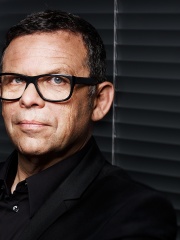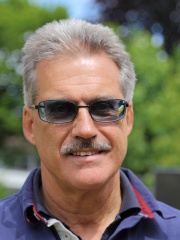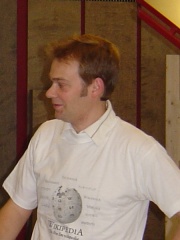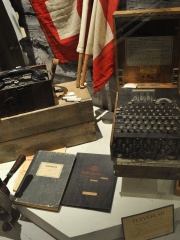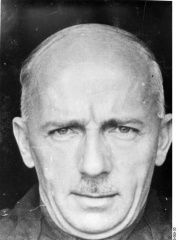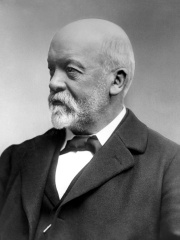
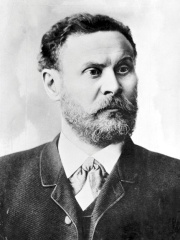
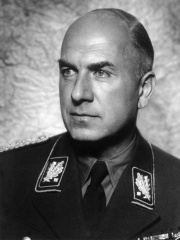

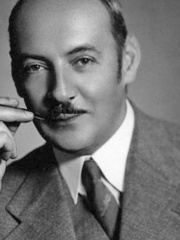
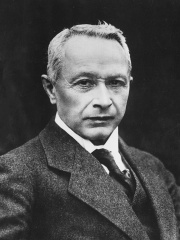
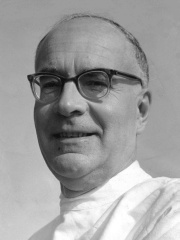
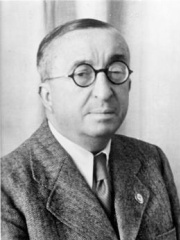
The Most Famous
ENGINEERS from Germany
This page contains a list of the greatest German Engineers. The pantheon dataset contains 389 Engineers, 42 of which were born in Germany. This makes Germany the birth place of the 5th most number of Engineers behind United States, and Russia.
Top 10
The following people are considered by Pantheon to be the top 10 most legendary German Engineers of all time. This list of famous German Engineers is sorted by HPI (Historical Popularity Index), a metric that aggregates information on a biography's online popularity. Visit the rankings page to view the entire list of German Engineers.

1. Gottlieb Daimler (1834 - 1900)
With an HPI of 79.99, Gottlieb Daimler is the most famous German Engineer. His biography has been translated into 72 different languages on wikipedia.
Gottlieb Wilhelm Daimler (German: [ˈɡɔtliːp ˈdaɪmlɐ]; 17 March 1834 – 6 March 1900) was a German engineer, industrial designer and industrialist. He was a pioneer of internal-combustion engines and automobile development. He invented the high-speed liquid petroleum-fueled engine. Daimler and his lifelong business partner Wilhelm Maybach were two inventors whose goal was to create small, high-speed engines to be mounted in any kind of locomotion device. In 1883 they designed a horizontal cylinder layout compressed charge liquid petroleum engine that fulfilled Daimler's desire for a high speed engine which could be throttled, making it useful in transportation applications. This engine was called Daimler's Dream. In 1885 they designed a vertical cylinder version of this engine which they subsequently fitted to a two-wheeler, the first internal combustion motorcycle which was named the Petroleum Reitwagen (Riding Car) and, in the next year, to a coach, and a boat. Daimler called this engine the grandfather clock engine (Standuhr) because of its resemblance to a large pendulum clock. In 1890, they converted their partnership into a stock company Daimler Motoren Gesellschaft (DMG, in English – the Daimler Motors Corporation). They sold their first automobile in 1892. Daimler fell ill and took a break from the business. Upon his return he experienced difficulty with the other stockholders that led to his resignation in 1893. This was reversed in 1894. Maybach resigned at the same time, and also returned. Daimler died in 1900 and Wilhelm Maybach quit DMG in 1907. Daimler is seen as "the father of the motorcycle".

2. Otto Lilienthal (1848 - 1896)
With an HPI of 73.11, Otto Lilienthal is the 2nd most famous German Engineer. His biography has been translated into 58 different languages.
Karl Wilhelm Otto Lilienthal (German pronunciation: [ˈkaʁl ˈvɪlhɛlm ˈʔɔto ˈliːliəntaːl]; 23 May 1848 – 10 August 1896) was a German pioneer of aviation who became known as the "flying man". He was the first person to make well-documented, repeated, successful flights with gliders, therefore making the idea of heavier-than-air aircraft a reality. Newspapers and magazines published photographs of Lilienthal gliding, favourably influencing public and scientific opinion about the possibility of flying machines becoming practical. Lilienthal's work led to his developing the concept of the modern wing. His flight attempts in 1891 are seen as the beginning of human flight and the "Lilienthal Normalsegelapparat" is considered the first airplane in series production, making the Maschinenfabrik Otto Lilienthal in Berlin the first airplane production company in the world. He has been referred to as the "father of aviation" and "father of flight". On 9 August 1896, Lilienthal’s glider stalled and he was unable to regain control. Falling from about 15 metres (49 ft), he broke his neck and died the next day.

3. Fritz Todt (1891 - 1942)
With an HPI of 72.68, Fritz Todt is the 3rd most famous German Engineer. His biography has been translated into 45 different languages.
Fritz Todt ([fʁɪt͡s tot]; 4 September 1891 – 8 February 1942) was a German construction engineer and senior figure of the Nazi Party. He was the founder of Organisation Todt (OT), a military-engineering organisation that supplied German industry with forced labour, and served as Reich Minister for Armaments and Ammunition in Nazi Germany early in World War II, directing the entire German wartime military economy from that position. An engineer by training, Todt served in the Luftstreitkräfte during World War I and was a recipient of the Iron Cross. He joined the Nazi Party in 1922 and the Sturmabteilung (SA) in 1931. Steadily rising through the ranks, Todt became Inspector General for German Roadways after Adolf Hitler came to power. In that capacity, he was responsible for the construction of the German autobahns. In 1938, he founded Organisation Todt and directed large-scale engineering projects such as the Westwall (Siegfried Line) and the Atlantic Wall. In 1940, he was appointed Reich Minister of Armaments and War Production. During World War II Todt made extensive use of forced labour, with as many as 800,000 labourers from German-occupied territories in the service of his organisation. Todt was killed along with four other people in February 1942 near Wilhelmsdorf when his aircraft crashed en route from Rastenburg to Berlin-Tempelhof. He was succeeded as Reichsminister and head of the OT by Albert Speer.

4. August Horch (1868 - 1951)
With an HPI of 70.87, August Horch is the 4th most famous German Engineer. His biography has been translated into 33 different languages.
August Horch (12 October 1868 – 3 February 1951) was a German engineer and automobile pioneer, the founder of the manufacturing giant that eventually became Audi.
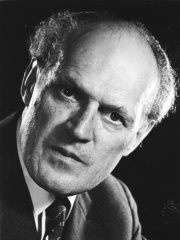
5. Willy Messerschmitt (1898 - 1978)
With an HPI of 70.80, Willy Messerschmitt is the 5th most famous German Engineer. His biography has been translated into 38 different languages.
Wilhelm Emil "Willy" Messerschmitt (German pronunciation: [ˈmɛsɐʃmɪt]; 26 June 1898 – 15 September 1978) was a German aircraft designer and manufacturer who designed a number of prominent aircraft for the Luftwaffe and civil aviation. Messerschmitt designed a number of successful motor gliders and airliners in the early 1920s until the BFW M.20 damaged his reputation, put his company into bankruptcy, and earned the hate of future Reich Aviation Ministry chief Erhard Milch. Messerschmitt rebuilt his company and produced a number of successful military aircraft for the Luftwaffe during World War II, until he was blacklisted from government contracts by Milch in 1941 and the Me 210 damaged his reputation again in 1942, forcing him to resign as director and into a research and development role. Messerschmitt was accused of using forced labor for aircraft production and convicted of collaborating with the Nazi regime in 1948. Messerschmitt worked in Spain until returning to Germany in 1955, serving as director of Messerschmitt AG until his retirement in 1970. Messerschmitt designed the Messerschmitt Bf 109 in collaboration with Walter Rethel, which became the most important fighter aircraft in the Luftwaffe and remains the second most-produced warplane in history, with some 34,000 built. Messerschmitt's Bf 109R, later redesignated Messerschmitt Me 209, broke the absolute world airspeed record and held the world speed record for propeller-driven aircraft until 1969. Messerschmitt's firm also produced the first jet-powered fighter to enter service – the Messerschmitt Me 262.

6. Albert Göring (1895 - 1966)
With an HPI of 69.54, Albert Göring is the 6th most famous German Engineer. His biography has been translated into 31 different languages.
Albert Günther Göring (9 March 1895 – 20 December 1966) was a German engineer, businessman, and the younger brother of Hermann Göring (head of the German Luftwaffe, founder of the Gestapo, and leading member of the Nazi Party). In contrast to his brother, Albert was opposed to Nazism, and helped Jews and others persecuted in Nazi Germany. He was shunned in post-war Germany because of his family name, and died without any public recognition, receiving scant attention for his humanitarian efforts until decades after his death.

7. Hugo Junkers (1859 - 1935)
With an HPI of 68.67, Hugo Junkers is the 7th most famous German Engineer. His biography has been translated into 42 different languages.
Hugo Junkers (3 February 1859 – 3 February 1935) was a German aircraft engineer and aircraft designer who pioneered the design of all-metal airplanes and flying wings. His company, Junkers Flugzeug- und Motorenwerke AG (Junkers Aircraft and Motor Works), was one of the mainstays of the German aircraft industry in the years between World War I and World War II. His multi-engined, all-metal passenger and freight planes helped establish airlines in Germany and around the world. In addition to aircraft, Junkers also built both diesel and petrol engines and held various thermodynamic and metallurgical patents. He was also one of the main sponsors of the Bauhaus movement and facilitated the move of the Bauhaus from Weimar to Dessau (where his factory was situated) in 1925. Amongst the highlights of his career were the Junkers J 1 of 1915, the world's first practical all-metal aircraft, incorporating a cantilever wing design with virtually no external bracing, the Junkers F 13 of 1919 (the world's first all-metal passenger aircraft), the Junkers W 33 (which made the first successful heavier-than-air east-to-west crossing of the Atlantic Ocean), the Junkers G.38 "flying wing", and the Junkers Ju 52, affectionately nicknamed "Tante Ju", one of the most famous airliners of the 1930s. When the Nazis came into power in 1933, they requested Junkers and his businesses aid in the German re-armament. When Junkers declined, the Nazis placed him under house arrest in 1934 and eventually seized control of his patents and company. He died the following year. Under Nazi control, his company produced some of the most successful German warplanes of the Second World War.

8. Felix Wankel (1902 - 1988)
With an HPI of 68.13, Felix Wankel is the 8th most famous German Engineer. His biography has been translated into 35 different languages.
Felix Heinrich Wankel (German: [ˈfeːlɪks ˈhaɪnʁɪç ˈvaŋkl̩]; 13 August 1902 – 9 October 1988) was a German mechanical engineer and inventor after whom the Wankel engine was named. Wankel joined various radical antisemitic organizations after World War I and was a prominent member of the Nazi Party.

9. Ernst Heinkel (1888 - 1958)
With an HPI of 67.50, Ernst Heinkel is the 9th most famous German Engineer. His biography has been translated into 34 different languages.
Dr. Ernst Heinkel (24 January 1888 – 30 January 1958) was a German aircraft designer, manufacturer, Wehrwirtschaftsführer in Nazi Germany, and member of the Nazi Party. His company Heinkel Flugzeugwerke produced the Heinkel He 178, the world's first turbojet-powered aircraft, and the Heinkel He 176, the first rocket aircraft.
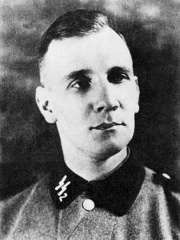
10. Kurt Gerstein (1905 - 1945)
With an HPI of 66.79, Kurt Gerstein is the 10th most famous German Engineer. His biography has been translated into 24 different languages.
Kurt Gerstein (11 August 1905, Münster, German Empire – 25 July 1945, Paris, France) was a German mining engineer, an anti-Nazi Christian activist, yet a member of the Nazi Party from 1933, of the SA in 1934, and later of the SS Hygiene Institute (Hygiene-Institut der Waffen-SS) from 1941 in Berlin. In August 1942, he witnessed a homicidal gassing at the Belzec extermination camp in Poland. He contacted a Swedish diplomat and religious figures in an attempt to alert political leaders and Pope Pius XII to the extermination of the Jews of Europe, but without success. In 1945, he provided an account that forms the core of his “report” to the Allies. During his imprisonment in France later that year, he was found hanged in his cell under circumstances that were never fully clarified. Gerstein’s legacy endures primarily through his writings, which notably inspired the 1963 play The Deputy by Rolf Hochhuth and the 2002 film Amen. by Costa-Gavras.
People
Pantheon has 42 people classified as German engineers born between 1806 and 1972. Of these 42, 4 (9.52%) of them are still alive today. The most famous living German engineers include Peter Schreyer, Mario Theissen, and Willy Rampf. The most famous deceased German engineers include Gottlieb Daimler, Otto Lilienthal, and Fritz Todt. As of April 2024, 1 new German engineers have been added to Pantheon including Roland Baar.
Living German Engineers
Go to all RankingsPeter Schreyer
1953 - Present
HPI: 54.74
Mario Theissen
1952 - Present
HPI: 53.96
Willy Rampf
1953 - Present
HPI: 51.22
Matthias Ettrich
1972 - Present
HPI: 46.80
Deceased German Engineers
Go to all RankingsGottlieb Daimler
1834 - 1900
HPI: 79.99
Otto Lilienthal
1848 - 1896
HPI: 73.11
Fritz Todt
1891 - 1942
HPI: 72.68
August Horch
1868 - 1951
HPI: 70.87
Willy Messerschmitt
1898 - 1978
HPI: 70.80
Albert Göring
1895 - 1966
HPI: 69.54
Hugo Junkers
1859 - 1935
HPI: 68.67
Felix Wankel
1902 - 1988
HPI: 68.13
Ernst Heinkel
1888 - 1958
HPI: 67.50
Kurt Gerstein
1905 - 1945
HPI: 66.79
Arthur Scherbius
1878 - 1929
HPI: 66.12
Walter Dornberger
1895 - 1980
HPI: 65.70
Newly Added German Engineers (2025)
Go to all RankingsOverlapping Lives
Which Engineers were alive at the same time? This visualization shows the lifespans of the 25 most globally memorable Engineers since 1700.

